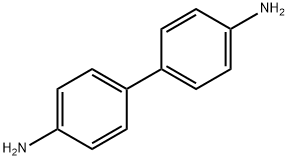Benzidine , 95% , 92-87-5
Synonym(s):
4,4′-Diaminobiphenyl
CAS NO.:92-87-5
Empirical Formula: C12H12N2
Molecular Weight: 184.24
MDL number: MFCD00039765
EINECS: 202-199-1
PRODUCT Properties
| Melting point: | 127-128 °C |
| Boiling point: | 402°C |
| Density | 1.25 |
| vapor pressure | Based on the specific vapor density value of 6.36 (Sims et al., 1988), the vapor pressure wascalculated to be 0.83 at 20 °C. |
| refractive index | 1.6266 (estimate) |
| Flash point: | 11 °C |
| storage temp. | 2-8°C |
| solubility | Soluble in ethanol (U.S. EPA, 1985) and ether (1 g/50 mL) (Windholz et al., 1983) |
| pka | 4.66(at 30℃) |
| color | Grayish-yellow, crystalline powder; white or sltlyreddish crystals, powder |
| Water Solubility | Sparingly soluble. <0.1 g/100 mL at 22 ºC |
| Merck | 13,1077 |
| BRN | 742770 |
| Henry's Law Constant | (x 10-11 atm?m3/mol):
3.88 at 25 °C (estimated, Howard, 1989) |
| Exposure limits | Because it is a carcinogen and readily
absorbed through skin, no TLV has been
assigned. Exposure should be at an absolute
minimum. Recognized Human Carcinogen (ACGIH); Human Carcinogen (MSHA); Carcinogen (OSHA); Human Sufficient Evidence, Animal Sufficient Evidence (IARC). |
| Stability: | Stable. Combustible. Incompatible with strong oxidizing agents. |
| InChIKey | HFACYLZERDEVSX-UHFFFAOYSA-N |
| CAS DataBase Reference | 92-87-5(CAS DataBase Reference) |
| IARC | 1 (Vol. 29, Sup 7, 99, 100F) 2012 |
| NIST Chemistry Reference | Benzidine(92-87-5) |
| EPA Substance Registry System | Benzidine (92-87-5) |
Description and Uses
Benzidine is a white, greyish-yellow, or slightly reddish crystalline solid or powder. The major use for benzidine is in the production of dyes, especially azo dyes in the leather, textile, and paper industries and as a synthetic precursor in the preparation and manufacture of dyestuffs. It is also used in the manufacture of rubber, as a reagent, and as a stain in microscopy. It is slightly soluble and slowly changes from a solid to a gas.
Benzidine was used extensively in the manu facture of dyes. Because of its cancer-causingeffects in humans, its application in dyes hasbeen curtailed. Other uses of this compoundare in chemical analysis: as a reagent for thedetermination of hydrogen peroxide in milkand in the analysis of nicotine. Its hydrochlo ride is used as a reagent to analyze metalsand sulfate.
Safety
| Symbol(GHS) |    GHS07,GHS08,GHS09 |
| Signal word | Danger |
| Hazard statements | H302-H350-H410 |
| Precautionary statements | P201-P202-P264-P273-P301+P312-P308+P313 |
| Hazard Codes | T,N,F,Xn |
| Risk Statements | 45-22-50/53-52/53-39/23/24/25-23/24/25-11-36/37/38-20/21/22-51/53-67 |
| Safety Statements | 53-45-60-61-36/37-16-7-36-26 |
| RIDADR | UN 1885 6.1/PG 2 |
| WGK Germany | 3 |
| RTECS | DC9625000 |
| F | 8 |
| HazardClass | 6.1(a) |
| PackingGroup | II |
| HS Code | 29215900 |
| Hazardous Substances Data | 92-87-5(Hazardous Substances Data) |
| Toxicity | Acute oral LD50 for mice 214 mg/kg, rats 309 mg/kg (quoted, RTECS, 1985). |


